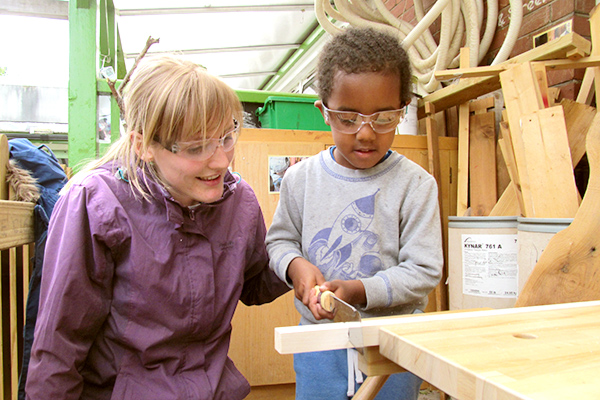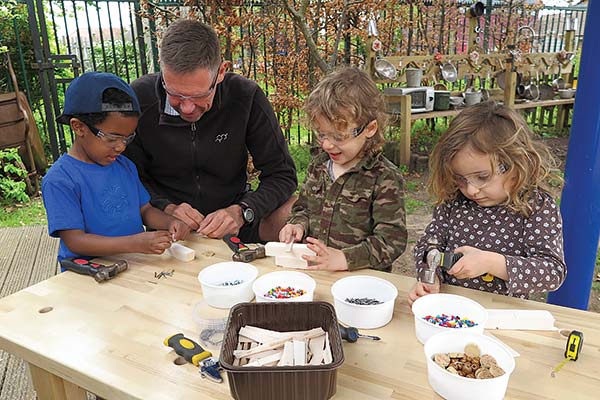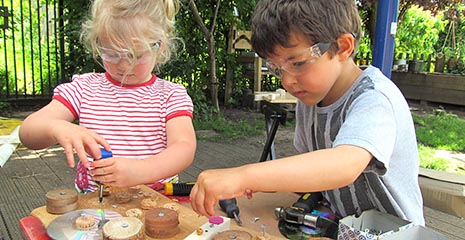Woodwork: irresistible learning
| June 2018Why should children learn to work with wood?
These are exciting times. The last few years have seen a surge of interest in woodworking in early years education. Some settings are starting from scratch, while for others it’s a case of dusting down the workbench and digging out the tools after many years of neglect.
This is a welcome shift as the benefits of woodwork for children's learning and development are astounding across all areas of the curriculum. Teachers who provide woodwork regularly observe exceptional levels of sustained engagement and intense concentration. Woodwork engages hands, minds and hearts. Children become engrossed and develop persistence and perseverance for challenging tasks – especially tasks with complex problem solving; it is not unusual for them to spend all morning at the woodwork bench.

The growing popularity of woodwork is not surprising given the levels of children’s enjoyment and the fact that it provides such a profound learning experience. The renewed interest is perhaps a reaction to our increasingly digital world, where children currently in nursery schools learn to “swipe” before learning to walk. Children are surrounded by complex technology but this has limited their experience of basic technology, with fewer opportunities to watch and learn and to understand processes. In past years there was a marked decline of woodwork in primary and secondary schools with less than half of pupils ever using tools in their entire education. Thankfully “making” is back in fashion, with a renewed interest in craft and upcycling – maybe in reaction to our overly homogenised world. Woodwork gives children the experience of building and repairing, countering our current and prevalent culture of consuming and disposing. The rise of forest school movement has also contributed: working with tools in a woodland environment is strongly advocated.
Perhaps the biggest factor in moving towards woodwork has been the shifting attitudes around risk aversion and over-zealous health and safety measures. Following from Lord Young's review of Health and Safety 2010: Common Sense Common safety, and subsequent guidance from the Health and Safety Executive (2012), the DoE (2013) and recently from Ofsted (2017), schools have felt encouraged to take a more balanced attitude towards risk, with many settings feeling more confident about embracing woodwork once again. This is a significant shift in our culture, and though still in its infancy, should be wholeheartedly celebrated.
There is something really special about woodwork. It is so different from other activities. The smell and feel of wood, using real tools, working with a natural material, the sounds of hammering and sawing, hands and minds working together to express their imagination and to solve problems, the use of strength and coordination: all work together to captivate young children’s interest.

Woodwork fosters personal development
We observe children working with their hands, tinkering, constructing models, and working on projects, but in fact the real transformation is inside the child – personal development is at the heart of woodwork.
Woodwork is a powerful activity for building self-esteem and confidence. Children feel empowered and valued by being trusted and given responsibility to work with real tools. They accomplish tasks that they initially perceive to be difficult and show satisfaction in their mastery of new skills, taking immense pride in their creations. This sense of empowerment and achievement provides a visible boost to their self-esteem and confidence. Children have a natural desire to construct and build. They learn how things work and discover that they can shape the world around them by creating things. This supports a can-do attitude and imbues children with a strong sense of agency, giving them a proactive disposition towards the world.
When we analyse a woodworking session it is awe-inspiring to see just how much learning is involved. Woodworking encompasses all areas of learning and development and invites connections between different aspects of learning. It supports current thinking on how children learn best, embracing all the characteristics of effective learning, and endows confident, creative learners with a passion for life-long learning. Woodwork really can be central to the curriculum. It incorporates mathematical thinking, scientific investigation, technological knowledge, physical development and coordination, communication and language, personal and social development, and a deepening understanding of the world.
Woodwork provides another media through which children can express themselves. It is unrivalled in terms of providing children with problem solving opportunities and challenge. Children are drawn in as they explore possibilities, rise to challenges and find solutions. I know no other activity that promotes creativity and critical thinking in quite the same way that woodwork does, both in terms of imagination and problem-solving as children make choices, find solutions, learn through trial and error and reflect on their work. I believe this is really at the heart of woodwork’s appeal and success.
Some children particularly flourish when working with wood: three-dimensionally and with their hands. It is hard to predict who will respond particularly positively as the skills are so different from those usually used in the early years. The experience of woodwork can be the key that unlocks some children’s learning.
The confidence to work with tools provides a skill set for life. Many children will need practical skills for their future work and woodwork in the early years could well be children's only experience of working with tools. Fortunately working with tools leaves a deep memory – so even if early childhood education is their only experience of working with wood it will leave a long-lasting impression. Many adults recount that experiencing woodwork as a child is one of the memories from early childhood that still stands out.
With woodwork children can develop their learning at their own pace and work through their own challenges. Once they have mastered basic skills, they move into open-ended exploration - tinkering, exploring possibilities and then they start making unique creations. Some teachers and parents are surprised that we introduce woodwork to children as young as three, but it must be emphasised that it is a low risk activity when introduced and monitored correctly. We at St Werburgh’s have been successfully woodworking with preschool children for many years with no significant incidents. Woodwork is one of the most popular activities and incorporates so much learning. Let’s make the opportunity of woodwork available to all children!
References
Early Years Woodwork Association
Example Risk assessment form and Health and Safety checklist
Woodwork in Early Years CPD training
http://irresistible-learning.co.uk/training/
Resources
Tools: www.cosydirect.com , www.muddyfaces.co.uk
Balsawood: www.balsacabin.co.uk
Workbenches: www.communityplaythings.co.uk






